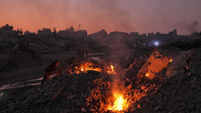Stalls filled with food in starving Niger
While mothers continue to bring children weak with hunger to feeding centres in Niger, market stalls are filled with food – but at prices well out of the reach of many in this desperately poor nation.
“It is the government’s job to deal with the hungry, we the traders are here for business,” said Ibrahim Baye, who sells millet, a staple in Niger, at Maradi market.
The well-stocked markets are deceptive. The food shortage is real. Last year locusts, in the worst invasion in 15 years, ravaged 7,000 square miles of Niger farmland.
That and a subsequent drought cut cereal production by 15% last year, according to the UN
Hunger was a problem in Niger even before the locusts and drought.
Today, more than a third of the nearly 12 million people in Niger face severe food shortages. Children are most at risk.
Yesterday, Baye shooed away beggars dressed in rags and staring at the heaped food on display.
A friend sitting with him who gave only one name, Louali, said the grains on display had been stockpiled “and traders wait until the lean season to sell at double its price.”
Hundreds of mothers who cannot buy turn up daily at feeding centres like one run by Doctors Without Borders in Aguie, 28 miles east of Maradi.
“At this time last year we had 300 admissions in our centres, today the number stands at 1,037,” Dr. Ibrahima Alzouma said. “We are just completely overwhelmed.”
Children have been left so fragile that even a change in the weather can be a threat.
Doctors say a fine rain yesterday, the first in 12 days, and slightly cooler air almost killed Firdaoussou Bassirou.
Firdaoussou, 7 months and weighing just 5.73 pounds – the weight of a newborn baby – was moved into the intensive care unit after her temperature dropped.
Her mother looked on helplessly as doctors try to place a drip on Firdaoussou’s collapsed veins.
Until international food aid reaches the most vulnerable, UNICEF is trying to bridge the gap by setting up community-managed cereal banks for those who can still afford to pay for food.
To avoid any speculation or the millet finding itself onto local markets, only a weekly family ratio is sold.
The experiment is yielding results throughout the region of Maradi and Zinder, where 200 cereal banks have been set up.
In 2004, some 78,241 people regularly purchased rations of millet in Aguie’s cereal bank.
:: Niger’s President Mamadou Tandja claimed yesterday that the food crisis was easing, and announced plans to create food stocks to prevent people here from going hungry again.
“We can observe with relief that the situation is improving and that our anxieties won’t take long to dissipate,” Tandja said in a speech on the eve of the country’s 45th anniversary of independence from France.
The UN food agency was also looking ahead yesterday, appealing for aid to provide Niger’s farmers with seeds for the next planting season and to replenish the livestock of families who have lost or been forced to sell their animals.
If the stricken farmers and herders are not helped to recover before the planting season starts in October, even larger amounts of food aid will be needed to prevent them from starving, the Rome-based Food and Agriculture Organisation said.













